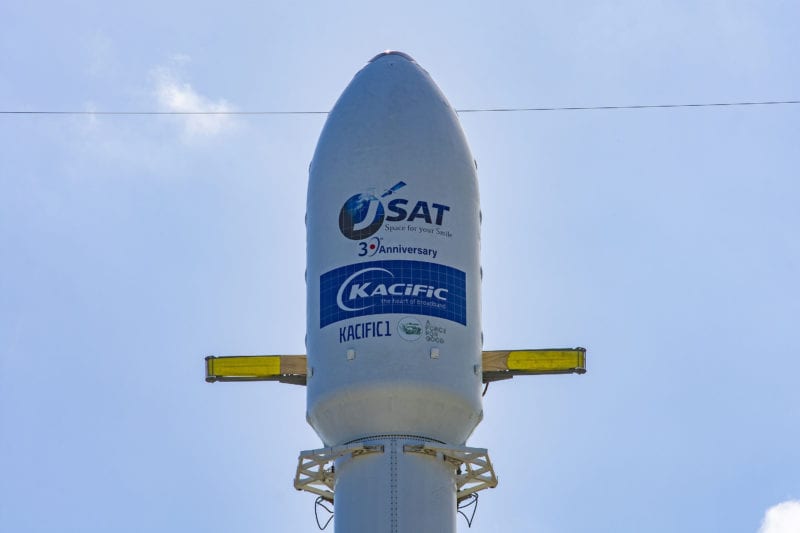Latest News
JSAT President Says Company is Exploring Opportunities in Imagery Data, Quantum Communications

SpaceX’s Dec. 16 launch of the JCSAT-18/Kacific-1 satellite carried payloads for Sky Perfect JSAT and Kacific Broadband Satellites Group. Photo: Kacific
Sky Perfect JSAT (JSAT) is considering a long-term play in several new markets, including the Earth Observation (EO) and data analytics markets, JSAT Executive Officer and Group President of Global Business Mitsutoshi Akao told Via Satellite. JSAT, Asia’s largest satellite operator based in Japan, is working closely with U.S.-based imagery analytics companies Planet and Orbital Insights to develop a new business in Japan.
“The data intelligence market could be a key market, maybe not now, but definitely in the future,” said Akao. “We believe this has a great potential for satellite operators. We are also doing a study with the Japanese government to develop and commercialize quantum communication service. I think space business and quantum communication go well together and have a good chemistry. This too, may not be our core business tomorrow but in a longer horizon, has a huge potential.”
For operators like JSAT which can no longer rely on broadcast revenues, one of the keys to longevity is being able to target new markets. JSAT recently launched two new satellites in the last nine months. The first, JCSAT-18, a new High Throughput Satellite (HTS) which has been renamed JCSAT-1C, was launched in December. This is JSAT’s second HTS, adding to the Horizons 3e satellite that was launched in 2018.
The JCSAT-17 satellite was launched in February. The main customer on this satellite will be major Japanese telco, NTT DoCoMo which uses bandwidth to provide a variety of services across Japan. “Capacity demand is growing for sure particularly in cellular backhaul, maritime, [In-Flight Connectivity] IFC, and we will be busy selling this bandwidth over the next few years,” Akao said.
While both of these satellites operate in Geostationary Orbit, (GEO), Akao says JSAT is keeping an eye on Low-Earth Orbit (LEO) as operators like SES and Telesat invest in this area.
“Our view has consistently been that both GEO and LEO have its own unique advantage over the other. We feel there will be certain markets LEO fits better than GEO,” Akao said. “That said, LEO constellations continue to have challenges toward starting full-fledged global services. We continue to closely watch how each project progresses. We could seek to collaborate if necessary. Ultimately, the end user does not really care whether it is LEO or GEO. What is important is our customer gets the best service that is available in the industry and we make sure we provide to them.”
Can operators like JSAT survive on having just a GEO strategy? Akao says if we are talking about the next five years, then the answer is yes.
“Studying LEO projects also lets us become aware of the competence of GEO. It is powerful that a single GEO satellite allows us to provide consistent, reliable service to specific customers. Also, it may be worth mentioning that the technologies in GEO payloads are improving. For instance, the throughput of HTS is consistently increasing. The flexibility is improving. GEO has been our core business and it will continue to be so. It is important that we make sure we will do what we are good at,” he said.
While broadcast services may not be the growth market it was in previous years, it still represents a significant source of JSAT’s revenue. Akao said JSAT sees some demand for bandwidth for video in Asia where populations are growing. “The definition is going higher from HD to 4K and then to 8K, which we have already started broadcasting at our premier 110 degrees East slot. I think we can at least say the video market will continue to be a key market for some time for the industry and it is not something that disrupted tomorrow,” he commented.
Akao also said that ground segment developments have come slower than JSAT has hoped. “Maybe we were too optimistic,” he said. “The ground piece is crucial for our industry, and new technologies such as flat antennas could open up new markets. Needless to say, ground terminals are a tangible interface with the users and I cannot emphasize just how important this is. We are eagerly looking forward to more developments, and will keep a close eye on these initiatives.”
Get the latest Via Satellite news!
Subscribe Now